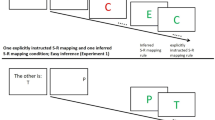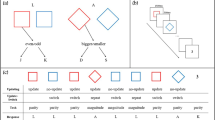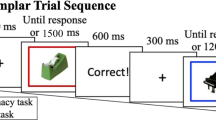Abstract
The cognitive system can be updated rapidly and efficiently to maximize performance in cognitive tasks. This paper used a task-switching task to explore updating at the level of the plausible task-sets held for future performance. Previous research suggested a “fadeout effect”, performance improvement when moving from task-switching context to single-task context, yet this effect could reflect passive learning rather than intentional control. In a novel “informed fadeout paradigm”, one of two tasks was canceled for a certain number of trials and participants were informed or uninformed regarding task cancelation. The “informed fadeout effect” indicates better performance in the informed than uninformed fadeout after one informed trial had been executed. However, the results regarding the first trial were inconclusive. Possible underlying mechanisms are discussed.









Similar content being viewed by others
Notes
We wish to thank Michael Ziessler, for reviewing this paper and suggesting this baseline.
The differentiation between the first and the more advanced trials was based on preliminary results that are reported in the Supplementary Materials S1 and S2, and also uses to test for a specific expected pattern.
Two preliminary experiments are reported in the Supplementary materials, both showing an informed fadeout effect—improved RT from the second informed trial relative to the uninformed condition. According to their results we decided to (a) use a constant fadeout length (Experiment S1) and (b) place the informed condition at the end of trial-blocks (Experiment S2).
The trend in PE was very noisy, and if anything showed an average increase in PE.
References
Tornay, F. J., & Milán, E. G. (2001). A more complete task-set reconfiguration in random than in predictable task switch. The Quarterly Journal of Experimental Psychology: Section A ,54, 785–803.
Allport, A., & Wylie, G. (2000). Task-switching, stimulus-response bindings and negative priming. In S. Monsell & J. Driver (Eds.), Control of cognitive processes: Attention and performance XVIII (pp. 35–70). Cambridge, MA: MIT.
Altmann, E. M. (2007). Comparing switch costs: alternating runs and explicit cuing. Journal of Experimental Psychology: Learning, Memory, and Cognition, 33, 475–483.
Botvinick, M. M., Braver, T. S., Barch, D. M., Carter, C. S., & Cohen, J. D. (2001). Conflict monitoring and cognitive control. Psychological Review ,108, 624–652.
Braver, T. S., Barch, D. M., Keys, B. A., Carter, C. S., Cohen, J. D., Kaye, J. A., Janowsky, J. S., Taylor, S. F., Yesavage, J. A., & Mumenthaler, M. S. (2001). Context processing in older adults: Evidence for a theory relating cognitive control to neurobiology in healthy aging. J. ournal of Experimental Psychology: General, 130, 746–763.
Bugg, J. M., & Braver, T. S. (2016). Proactive control of irrelevant task rules during cued task switching. Psychological Research, 80, 1–17.
Bugg, J. M., Diede, N. T., Cohen-Shikora, E. R., & Selmeczy, D. (2015). Expectations and experience: Dissociable bases for cognitive control? Journal of Experimental Psychology: Learning, Memory, and Cognition, 41, 1349–1373.
Cole, M. W., Laurent, P., & Stocco, A. (2013). Rapid instructed task learning: A new window into the human brain’s unique capacity for flexible cognitive control. Cognitive, Affective, & Behavioral Neuroscience,13, 1–22.
Dreisbach, G. (2012). Mechanisms of cognitive control the functional role of task rules. Current Directions in Psychological Science, 21, 227–231
Dreisbach, G., Goschke, T., & Haider, H. (2006). Implicit task sets in task switching? Journal of Experimental Psychology: Learning, Memory, and Cognition, 32, 1221–1233.
Dreisbach, G., & Haider, H. (2008). That’s what task sets are for: shielding against irrelevant information. Psychological Research, 72, 355–361.
Ecker, U. K., Lewandowsky, S., & Oberauer, K. (2014). Removal of information from working memory: A specific updating process. Journal of Memory and Language, 74, 77–90.
Faul, F., Erdfelder, E., Buchner, A., & Lang, A. G. (2009). Statistical power analyses using G* Power 3.1: Tests for correlation and regression analyses. Behavior Research Methods, 41, 1149–1160.
Gaschler, R., Frensch, P. A., Cohen, A., & Wenke, D. (2012). Implicit sequence learning based on instructed task set. Journal of Experimental Psychology: Learning, Memory, and Cognition, 38, 1389–1407.
Goldfarb, L., & Henik, A. (2013). The effect of a preceding cue on the conflict solving mechanism. Experimental Psychology, 60, 347–353.
Gopher, D., Armony, L., & Greenshpan, Y. (2000). Switching tasks and attention policies. Journal of Experimental Psychology: General, 129, 308–339.
Hartstra, E., Waszak, F., & Brass, M. (2012). The implementation of verbal instructions: dissociating motor preparation from the formation of stimulus–response associations. Neuroimage, 63, 1143–1153.
Hollands, J. G., & Jarmasz, J. (2010). Revisiting confidence intervals for repeated measures designs. Psychonomic Bulletin & Review, 17, 135–138.
Jarmasz, J., & Hollands, J. G. (2009). Confidence intervals in repeated measures designs: The number of observations principle. Canadian Journal of Experimental Psychology, 63, 124–138.
Jennings, J. R., & van der Molen, M. W. (2005). Preparation for speeded action as a psychophysiological concept. Psychological Bulletin, 131, 434–459.
Kiesel, A., Wendt, M., & Peters, A. (2007). Task switching: On the origin of response congruency effects. Psychological Research Psychologische Forschung, 71, 117–125.
Liefooghe, B., Wenke, D., & De Houwer, J. (2012). Instruction-based task-rule congruency effects. Journal of Experimental Psychology: Learning, Memory, and Cognition, 38, 1325–1335.
Love, J., Selker, R., Marsman, M., Jamil, T., Dropmann, D., Verhagen, A. J., & Wagenmakers, E. J. (2015). JASP (Version 0.7) [Computer software].
Mayr, U., & Liebscher, T. (2001). Is there an age deficit in the selection of mental sets? European Journal of Cognitive Psychology, 13, 47–69.
Mayr, U., Spieler, D. H., & Hutcheon, T. G. (2015). When and why do old adults outsource control to the environment?. Psychology and Aging, 30, 624–633.
Meiran, N. (1996). Reconfiguration of Processing Mode Prior to Task Performance. Journal of Experimental Psychology: Learning, Memory, and Cognition, 22, 1423–1442.
Meiran, N. (2010). Task switching: Mechanisms underlying rigid vs. flexible self-control. In R. Hassin, K. Ochsner & Y. Trope (Eds.), Self-control in society, mind and brain (pp. 202–220). NY: Oxford University Press.
Meiran, N. (2014). The task cuing paradigm: A user’s guide. In J. A. Grange & G. Houghton (Eds.), Task switching and cognitive control (pp. 45–73). Oxford University Press.
Meiran, N., Chorev, Z., & Sapir, A. (2000). Component processes in task switching. Cognitive Psychology, 41, 211–253.
Meiran, N., Diamond, G. M., Toder, D., & Nemets, B. (2011). Cognitive rigidity in unipolar depression and obsessive compulsive disorder: Examination of task switching, Stroop, working memory updating and post-conflict adaptation. Psychiatry Research, 185, 149–156.
Meiran, N., Gotler, A., & Perlman, A. (2001). Old age is associated with a pattern of relatively intact and relatively impaired task-set switching abilities. The Journals of Gerontology Series B: Psychological Sciences and Social Sciences, 56, 88–102.
Meiran, N., & Kessler, Y. (2008). The task rule congruency effect in task switching reflects activated long-term memory. Journal of Experimental Psychology: Human Perception and Performance 34, 137–157.
Meiran, N., Kessler, Y., & Adi-Japha, E. (2008). Control by action representation and input selection (CARIS): A theoretical framework for task switching. Psychological Research, 72, 473–500.
Meiran, N., Pereg, M., Kessler, Y., Cole, M. W., & Braver, T. S. (2015). The power of instructions: Proactive configuration of stimulus–response translation. Journal of Experimental Psychology: Learning, Memory, and Cognition, 41, 768–786.
Monsell, S. (2003). Task Switching. Trends in Cognitive Sciences, 7, 134–140.
Monsell, S., Sumner, P., & Waters, H. (2003). Task-set reconfiguration with predictable and unpredictable task switches. Memory & Cognition, 31, 327–342.
Oberauer, K., Souza, A. S., Druey, M. D., & Gade, M. (2013). Analogous mechanisms of selection and updating in declarative and procedural working memory: Experiments and a computational model. Cognitive Psychology, 66, 157–211.
Psychology Software Tools (2010). E-Prime 2.0. Sharpsburg, PA: Psychology Software Tools, Inc.
Rogers, R. D., & Monsell, S. (1995). The cost of a predictable switch between simple cognitive tasks. Journal of Experimental Psychology: General, 124, 207–231.
Rouder, J. N., Morey, R. D., Speckman, P. L., & Province, J. M. (2012). Default Bayes factors for ANOVA designs. Journal of Mathematical Psychology, 56, 356–374.
Rubin, O., & Meiran, N. (2005). On the origins of the task mixing cost in the cuing task-switching paradigm. Journal of Experimental Psychology: Learning, Memory, and Cognition, 31, 1477–1491.
Schmidt, J. R. (2013). Temporal learning and list-level proportion congruency: conflict adaptation or learning when to respond? PloS ONE, 8, e82320.
Shaffer, L. H. (1965). Choice reaction with variable S–R mapping. Journal of Experimental Psychology, 70, 284–288.
Smith, R. E. (2003). The cost of remembering to remember in event-based prospective memory: investigating the capacity demands of delayed intention performance. Journal of Experimental Psychology: Learning, Memory, and Cognition, 29, 347–361.
Spieler, D. H., Mayr, U., & LaGrone, S. (2006). Outsourcing cognitive control to the environment: Adult age differences in the use of task cues. Psychonomic Bulletin & Review, 13, 787–793.
Vandierendonck, A. (2016). A comparison of methods to combine speed and accuracy measures of performance: A rejoinder on the binning procedure. Behavior Research Methods. Advance online publication. doi:10.3758/s13428-016-0721-5.
Vandierendonck, A., Liefooghe, B., & Verbruggen, F. (2010). Task switching: Interplay of reconfiguration and interference. Psychological Bulletin, 136, 601–626.
Acknowledgements
We would like to thank Yoav Kessler for inspiring Experiment 3, and Gal Berger, Nitsan Dolev, Aylon Fisch, Eran Halavy, Dan Halunga and Shiri Omer for their help in data collection.
Author information
Authors and Affiliations
Corresponding author
Ethics declarations
This research was supported by a research grant from the USA–Israel Bi-national Science Foundation to the second author. The first author declares she has no conflict of interest. The second author declares he has no conflict of interest.
All procedures performed in this study involving human participants were in accordance with the ethical standards of the institutional research committee. Informed consent was obtained from all individual participants included in the study.
Electronic supplementary material
Below is the link to the electronic supplementary material.
Appendices
Appendix: Task-rule congruency effect (TRCE)
The Task-Rule Congruency Effect (TRCE) might help understanding the mechanism at the basis of the informed-fadeout effect. In short, if the informed fadeout includes the removal of the irrelevant task set from WM, it should not interfere with the relevant task, and thus not cause TRCE. Nonetheless, TRCE is considered to be based on two structures—both activated long-term memory (A-LTM), consisting of all the task-relevant representations, that would not be eliminated during a short-fadeout; and residual bindings in the bridge, which only holds the currently relevant task rules (Oberauer et al., 2013; see also; Kiesel, Wendt, & Peters, 2007). Below, we present results involving Congruency in the three experiments presented in this study. Since there were generally no consistent results regarding TRCE, we pooled the three experiments to increase statistical power (Experiment was entered as a between-subjects independent variable, and we used the lowest common denominator and included four trials within the fadeout sequence, and the short-informed condition from Experiment 2 (which was more comparable to the other experiments)). The results do not show an informed fadeout effect in TRCE.
Results and discussion
Importantly, none of the interactions with Congruency reached significance, including the interactions between Congruency and Experiment (suggesting that the TRCE patterns were not different between the experiments). We took the same set of planned comparisons as in the Results sections and added Congruency. In RT, none of the comparisons approached significance (all Fs < 0.86, ps > 0.35) (see Fig. 9).
However, some of the comparisons in PE reached significance. In the informed condition, a significant reduction in PE-TRCE was found between baseline and Trial 1 (by 4% erros) [F(1,79) = 6.40, p = .01, MSE = 0.007, Ƞ2 p = 0.07], and this trend was significantly different than the uninformed condition [F(1,79) = 5.49, p = .02, MSE = 0.007, Ƞ2 p = 0.06]. However, this result seems to stem from an increase in PE in congruent trials [F(1,79) = 15.88, p < .001, MSE = 0.002, Ƞ2 p = 0.17] and not from a decrease in PE in incongruent trials [F(1,79) = 1.71, p = .19, MSE = 0.011, Ƞ2 p = 0.02]. Other effects nearly approaching significance were the difference in PE-TRCE in Trial 1 between the fadeout conditions (which was higher in the informed condition by 3.36% errors) [F(1,79) = 3.39, p = .07, MSE = 0.006, Ƞ2 p = 0.04]; the difference in PE-TRCE in Trials 2–4 between the fadeout conditions [F(1,79) = 3.08, p = .08, MSE = 0.005, Ƞ2 p = 0.04]. Other than these trends, none of the other comparisons approached significance [all Fs < 2.07, ps > 0.15].
Importantly, a significant TRCE was found in Trials 2–4 in both RT [F(1,78) = 4.45, p = .04, MSE = 6,678.08, Ƞ2 p = 0.05] and PE [F(1,79) = 7.66, p < .01, MSE = 0.005, Ƞ2 p = 0.09].
The consistent TRCE in both RT and PE seen in the informed fadeout condition indicates that the irrelevant task was not removed from WM. Nonetheless, it is still possible that there was removal of information from the limited-capacity bridge part, holding procedural information, though not from A-LTM. Such a scenario predicts that TRCE would still emerge.
Rights and permissions
About this article
Cite this article
Pereg, M., Meiran, N. Evidence for instructions-based updating of task-set representations: the informed fadeout effect. Psychological Research 82, 549–569 (2018). https://doi.org/10.1007/s00426-017-0842-1
Received:
Accepted:
Published:
Issue Date:
DOI: https://doi.org/10.1007/s00426-017-0842-1




